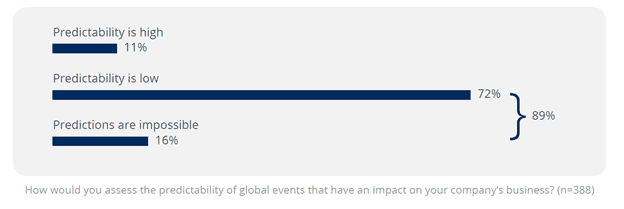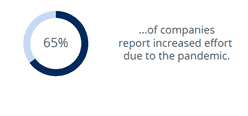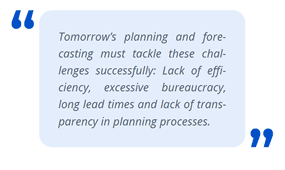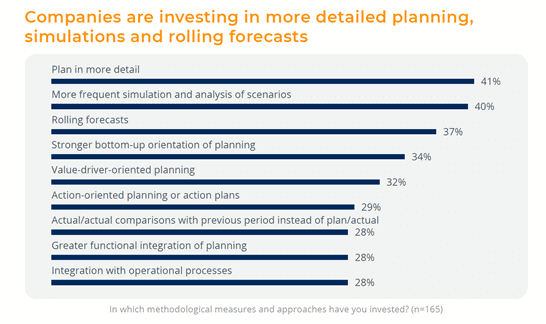What is the Future of Planning and Forecasting in a Post-Pandemic World?

The COVID-19 pandemic is a “black swan” event that caught most companies unprepared. This disruptive event was a wake-up call that the impact of uncertainty, dynamics, and complexity on markets could no longer be ignored. Going forward, local events in an increasingly interconnected global economy and uncertainties such as the climate crisis will continue to create high volatility and even chaos. Accordingly, many organizations will have to adjust their corporate governance to meet these demands.
While many organizations have adjusted their planning and forecasting processes in the past 18 months, some may have implemented short-term fixes that did not bring the significant and lasting improvements required. In a recent survey, Business Application Research Center (BARC) examined the contributions modern planning and forecasting can make to corporate management and the measures organizations are taking to meet the elevated requirements.
Planning and Forecasting in a Post-Pandemic World
Planning and forecasting processes in organizations around the world are being put to the test due to recent disruptions caused by the pandemic and shifted priorities. As a result, Finance executives and decision-makers are asking themselves the following questions: Is our approach still up to date? Is our chosen technology still fit for purpose? Does the effort match the benefit? Are there better methods we should be considering?
In order to assess the contribution that planning, budgeting, and forecasting can make in the future, BARC conducted a survey of more than 400 IT, Finance, and line of business executives. Conducted in May and June of 2021, the focus was to learn about their planning and forecasting challenges and requirements and the measures organizations are taking and planning to take to achieve their goals.
Here are the highlights of the 6 top survey findings.
1. In an increasingly dynamic world, the predictability of events is low.
In BARC’s Future of Planning survey, 89 percent (see Figure 1) of the companies surveyed believe that the predictability of important events that significantly affect their own business is low or close to zero. In an increasingly dynamic environment, traditional budgeting is losing relevance for many companies. Therefore, more than 80 percent of organizations agree that it will become more important to rely on more frequent and rapid forecasts to guide business decisions instead of elaborate budgeting in the future.

Figure 1 – The predictability of global events that impact business
The BARC survey found that today, four out of ten companies update their forecasts at least once a month, and for leaders, it is even more than six out of ten. This frequent and rapid forecasting is just not feasible with spreadsheets and legacy technologies – according to BARC, modern software tools are required to support more agile planning.
2. The importance of planning for agile corporate management has increased as a result of the pandemic.
The elevated importance of forecasts and plan revisions in the context of high uncertainty is reflected in the frequency with which companies put in increased effort. In the BARC survey, 65% of companies reported increased effort due to the pandemic. One driver for this was the need for many revisions due to significantly changed epidemiological parameters and the political measures taken to tackle the pandemic. As a result, investment in these areas has been extended rather than reduced, unlike many other areas.

3. Current challenges in planning and forecasting exist in almost every company.
As has been the case for many years, planning and forecasting is viewed with suspicion in many organizations. According to 95% of respondents to the BARC survey, planning and forecasting takes too long, ties up too many resources, produces high costs and the quality of the results is not good in relation to the effort involved.
In today’s dynamic environment, up-to-date information and frequent forecasts are essential to making well-founded decisions. Frequent, automated forecasts require a high-quality data inventory that is regularly fed with up-to-date data from internal and external sources. The time-consuming consolidation of this data from a variety of source systems not only involves plenty of effort but also delays its provision. As a result, the use of data from multiple sources is by far the main cause of many of the challenges mentioned above.

4. Modern software provides for better integration and stronger automation.
Organizations surveyed by BARC see the right software support as an essential lever for improving planning and forecasting. BARC is currently observing two trends here: an accelerated shift away from Excel to professional budgeting, planning, and forecasting software solutions and the replacement of software that no longer fits optimally with the revised requirements. Improved technical integration of financial and operational plans was identified as the top area of investment (54%), followed by stronger automation of data management between ERP systems and planning systems (50%). Introduction of new software (48%) and more comprehensive use of existing software (45%) were also in the top four.
5. Operational sub-plans and sophisticated simulations provide directly actionable findings.
The expansion of planning, which is often very financially oriented, to include operational sub-plans is one of the most important topics in planning and forecasting, according to BARC. The survey found (see Figure 2) that in recent months, a significant proportion of companies (41%) have pursued more detailed planning (higher level of detail, more sub-plans), invested in simulations and scenarios (40%), and changed year-end forecasts to rolling forecasts (37%).

Figure 2 – How companies are investing to improve planning
6. Tighter cooperation and greater competence accelerate processes and increase quality.
While modern technology can clearly have a positive impact on planning and forecasting, organizational adjustments are also needed to achieve the desired results. According to the BARC survey, 50% of companies have invested in providing better documentation and assistance for planners. 42% of respondents said they have focused on improving the competence of those running the planning process, including improved data and analytics skills. And 38% of respondents formed interdisciplinary teams who, among other things, could quickly adjust forecasts and projections based on developments in all areas of the business.
Suggested Actions
Based on the results of the survey and their consulting experience, BARC analysts formulated the following recommendations to help organizations align planning and forecasting with current and future requirements:
- Identify the time-wasters in your processes and address them.
- Evaluate the costs and benefits of planning and forecasting.
- Automate forecasts and projections with predictive methods (e.g., statistical methods or machine learning).
- Think beyond finance. Incorporating key operational sub-plans into your business model.
- Modernize your software if you have not already done so.
- Encourage collaboration and up-level the analytic skills of planners.
- Optimize technology, methods, and organization in a well-coordinated way.
Conclusions
According to BARC, isolated adjustments often only lead to short-term improvements. New methods usually require different software, but new software always enables new approaches and often more efficient processes. Software alone does not solve problems; it is merely the technological basis for an agile and flexible environment. However, the necessary skills for effective use must be actively built up. Completely relying on external expertise for changes and adaptations is no longer appropriate in the face of constant changes. To learn more, download a copy of BARC’s 2021 The Future of Planning Survey here.
Get Started With a Personal Demo


